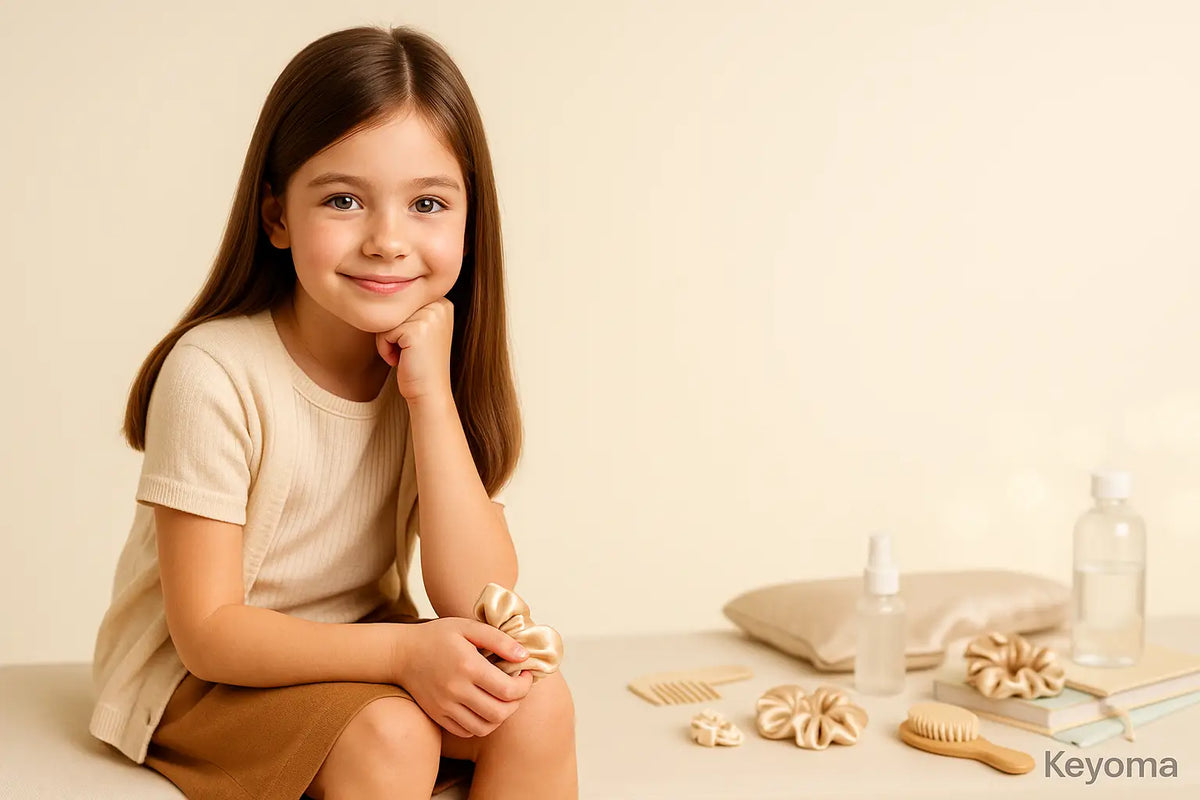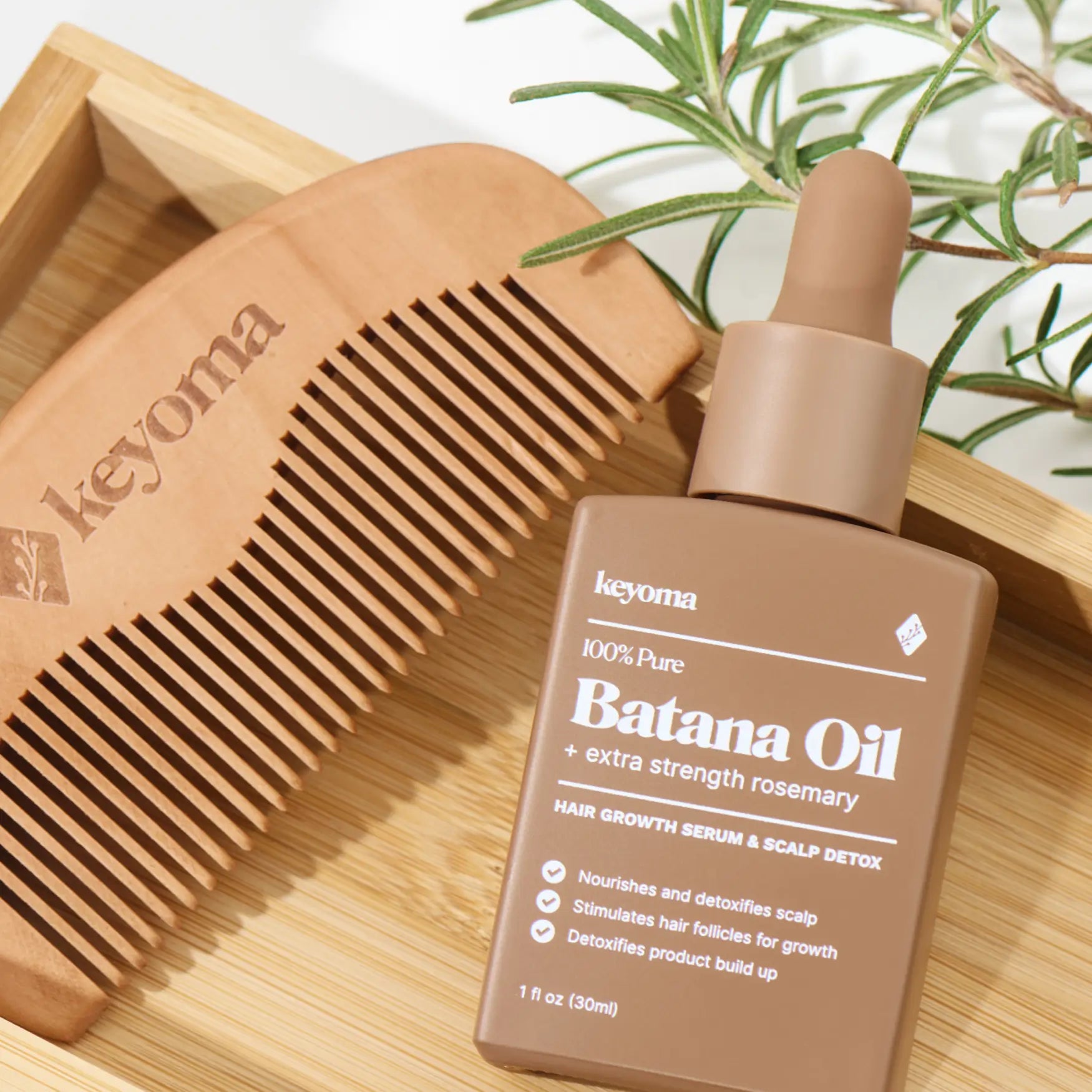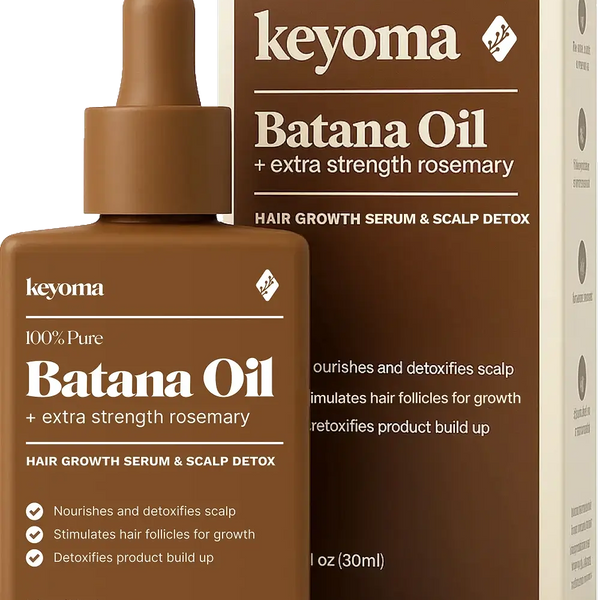In this article
Your child's hair starts forming in the womb. From birth, we have hair follicles that support healthy growth. How fast or how much your child's hair grows depends on genes, diet, environment, stress, and other factors.
Maybe you worry because your Mini Me's hair seems dry, knotty, and split-prone. Or your newborn's fuzz looks sparse and that makes you anxious.
To help hair grow faster, or at least at a steady rate, let's look at what shapes your child's hair growth and go over simple ways to support it.
Key Takeaways
-
Hair grows about half to one inch monthly, totaling around five to six inches yearly.
-
Gentle care and moisture retention reduce breakage: sulfate-free shampoo, deep conditioning, careful detangling, trims.
-
Scalp conditions like tinea capitis cause hair loss, and medical treatment supports recovery.
-
Protein, vitamin D, biotin, and zinc support growth, and supplements may address deficiencies.
Practical Hair Growth Tips for Kids
Hair grows at its own pace, and there's no instant trick for quick growth. Timelines vary from child to child.
Typically, an infant's birth hair sheds and then regrows soon after. This can take a while; hair usually only grows about 1/2 an inch to an inch per month. Each year, your kid can expect about 5 to 6 inches of growth.
For young children, choose gentle, natural products and keep a consistent hair care routine.
That way, the new hair coming in stays strong and healthy, building a foundation for long, full hair!

Use Deep Conditioner for Faster Growth
One reliable way to support children's hair growth is to replace moisture lost during washing. Used properly, deep conditioners boost needed hydration, soften strands, and reduce damage and split ends.
Choose a Gentle, Sulfate-Free Shampoo
Kids' hair is delicate and easily damaged. Strong, chemical-laden shampoos can strip natural oils, causing dryness and breakage. Today, many mild, sulfate-free shampoos clean well without robbing hair of moisture.
Detangle Gently to Prevent Breakage
Detangle during the conditioning step. After drying, work through sections gently with a wide-tooth comb and avoid excess force. Keep your child's hair secured neatly to limit knots.
Schedule Regular End Trims
It can feel backward, but trimming your child's ends can speed progress. When tips split, the break can travel up the strand, leading to more breakage. If not handled, split ends may affect the roots. Removing damage reduces breakage and supports healthy length.
Dry Hair the Right Way
Heat damage to hair can't be undone. For me, a diffuser on cool made styling gentler at home. Once your child's natural hair is harmed by heat, it won't return to its original state.
Heat-damaged strands break more, which can slow healthy growth. If you must use heat on your child's hair, use a heat protectant and the lowest settings.
Protect Ends With Low-Tension Styles
Protective styles help shield the ends from breakage and reduce exposure to harsh elements. They also limit tangles during play, which supports growth and preserves length.
Try braids, buns, or ponytails. Use hair ties without metal parts. With good moisture and protective styling, hair tends to do well.
Address Scalp Conditions Early
Address scalp problems in children to encourage growth. Common issues include scalp fungal infections and alopecia. Tinea capitis (ringworm) is contagious and can cause hair loss. If your child experiences these issues, consult a doctor for effective treatment.
Switch to a Satin Pillowcase
Sleeping on cotton can pull moisture from hair, which leads to dryness, frizz, and breakage. A satin pillowcase is a smart upgrade because it helps retain moisture and lowers friction on the hair.
Try Shampoos That Support Growth
Natural oils can encourage hair growth across hair types, assuming no allergies. People have used oils for centuries to nurture growth, repair damage, limit breakage, and calm dry, itchy scalps.
Essential Oils for Scalp Health
Essential oils are concentrated plant extracts with properties that can support hair health. Each oil brings its own traits that may benefit overall hair vitality.
When applying essential oils to the scalp, handle them carefully. Before using any essential oil more broadly, do a small patch test to check skin tolerance. Here are the steps for a patch test:
-
Pick a small spot on the inner forearm or behind the ear for testing.
-
Dilute the essential oil in a carrier, like coconut or olive oil, as directed. A 1–2% dilution usually works for patch tests.
-
Place a tiny amount of the diluted oil on the chosen skin area.
-
Cover that spot with a bandage or adhesive patch to limit evaporation.
-
Leave it on for 24–48 hours, checking now and then for irritation or allergy.
-
If you notice redness, itching, swelling, or discomfort, remove the bandage right away and wash with mild soap and water.
-
If no reaction appears after 48 hours, the oil is likely safe for scalp use.
Vitamins That Can Aid Kids' Hair Growth
As parents, you want the best for your children, and healthy hair matters. Hair that seems slow to grow can raise concerns. While there are no miracle solutions for instant growth, certain vitamins and supplements can support overall hair growth in kids.

1. Vitamin D
Vitamin D deficiency has been associated with hair loss and poor growth in children. Sunlight helps the body make vitamin D, but limited sun or darker skin can lead to low levels. If your child doesn't get enough from sunlight or diet, a vitamin D supplement might help correct a deficiency.
2. Biotin
Biotin, a water-soluble vitamin, helps keep follicles healthy by aiding keratin production, the protein that forms hair. Eggs, nuts, seeds, and fish are rich sources of biotin. If your child's diet lacks these foods, a biotin supplement could help.
3. Dietary Protein
Protein is essential for hair growth, serving as its fundamental building block. Make sure your child's meals include enough protein from lean meats, poultry, fish, eggs, dairy, legumes, and tofu. If intake is low, increase these sources.
4. Zinc
Zinc is a vital mineral that supports proper follicle function and promotes healthy growth. Foods like lean meats, legumes, nuts, and seeds are excellent sources. If your child has a limited diet or a zinc deficiency, a zinc supplement could be considered.
Reminder
-
Vitamins and supplements support hair health but won't give instant results.
-
Genetics, overall health, and daily hair care also affect growth.
-
Aim for a balanced diet, good hair hygiene, and regular medical checkups for the best outcome.
-
Talk with a pediatrician for tailored nutrition advice.
At-Home Remedies to Strengthen Your Child's Hair
With that in mind, here are common kitchen items that may aid and strengthen hair growth.
Batana Oil Hair Mask
Batana oil can help kids’ hair feel softer and stronger by cutting friction and reducing protein loss during washing and detangling. Triglyceride plant oils can move into the hair fiber and improve mechanical strength, and batana (Elaeis oleifera) is naturally rich in carotenoids and vitamin-E forms called tocotrienols that support the hair’s surface.
Use Keyoma Batana Oil with Rosemary as a simple pre-wash mask on length and ends. For children under 6, avoid scalp application because essential oils are potent; for older kids, use a tiny amount and patch test first, since rosemary is still an essential oil. Adult data suggests rosemary oil can support density with steady use, but the trial was in grownups, not children.
Egg Yolk Scalp Mask
An egg is a powerhouse of protein, though many children refuse to eat it. Beat one egg and apply the yolk on your child's scalp for about an hour, then rinse with baby shampoo.
Egg can also help hair feel thicker while giving nourishment. The smell may be off-putting, and your child might resist. You can hide it by adding a tablespoon of an essential oil like sandalwood or jasmine.
Yogurt Hair Mask
Yoghurt is a natural thickening product. Beat a cup well, apply it on your child's hair, and leave it for half an hour. You can do this every other day and may notice a difference.
Coconut Milk Treatment
Coconut milk nourishes dry and dull hair. The best time to apply it is after a hair wash. Leave it on the wet scalp for best results.
Aloe Vera Gel Treatment
Aloe vera can be grown at home with ease. Extract the gel from the leaves and apply it directly to the hair. It not only supports hair growth but also keeps it moisturized and cool. It can help prevent dandruff and reduce breakage and other damage.
Explore these 15 DIY hair masks that you could try at home.
Build a Gentle Kids' Hair Growth Routine With Keyoma
Reduce friction where it happens most. Trade cotton pillowcases for satin to help hair hold moisture and avoid morning knots. Detangle only under conditioner, then rinse and let hair air dry or use the lowest heat with protectant. If you try essential oils, keep a 1 to 2 percent dilution for a patch test and check the spot after 24 to 48 hours.
This week, wash with a gentle sulfate-free shampoo, detangle under slip with a wide-tooth comb, and book regular trims so damage does not travel. Track shedding, knots, and time to style in a notes app to see what truly helps. For safe hair care routines, ingredient guidance, and simple checklists, visit the Keyoma Hair Care blog.
Featured Product
100% Pure Batana Oil + Rosemary









